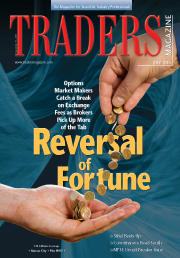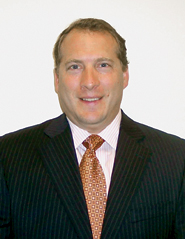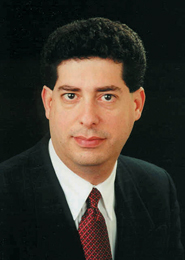The rules of the game are changing.

For most of their history, ever since the Chicago Board Options Exchange was created in 1973, the nation’s options exchanges have looked to market makers for their revenues. In return for a dominant role at the exchanges, market makers paid the lion’s share of the fees. Customers, on the other hand, traded for free.
See Sidebars:
SEC Looks to Put a Cap On Fees
Big Four Have Been There Before
That arrangement is now breaking down. Market makers pay exchanges less often to trade. And when they do pay, the fees are lower. To make up the shortfall, the exchanges are looking to the industry’s customers–by way of their brokers–to pay.
"In the past, market makers were making enough money that they could afford to bear the costs," said Slade Winchester, a director in Citigroup’s U.S. equity derivatives division. "But markets have tightened up to a level where market makers can’t continue to bear the cost and make tight markets. So the costs are shifting."
The shift is significant. The exchange structure was founded on the principle of giving the customer the advantage in his dealings with the marketplace. To allay fears that the options market was a rigged game, the industry gave customers priority over all other traders; plus, it let them trade for free.
In addition, the industry adopted the practice of paying brokers for their orders. Exchanges collect a "marketing" fee from market makers every time they trade against a customer order. Then, once a month, the exchanges distribute those fees to retail brokers. According to the brokers, the practice benefits the customers: It keeps commissions low and allows the brokers to improve their services.

All of this is being upended because market makers are making less money. Both the switch to trading in penny increments in January 2007 and stepped-up activity by high-frequency traders have cut into dealer profits. That has made the dealers less willing to shoulder the entire burden of supporting the exchanges.
Almost 90 percent of industry volume is now being traded in options subject to the "penny pilot." With the minimum trading increment down from 5 cents to 1 cent in the most active options, competition has cut dealer spreads dramatically.
In addition, technological advances and exchange customer-priority rules have permitted high-frequency traders to beat the market makers at their own game. Until recently, the traders had been able to use their "customer" status to match dealer quotes and step to the front of the queue. That allowed them to grab incoming orders that otherwise would have gone to market makers. And, of course, they traded for free.
That is no longer the case. Since last October, the International Securities Exchange has charged "professional" customers, or those trading more than 390 orders per day, to trade. The exchange started small, charging the pros 20 cents per contract for trades in certain ISE facilities, but recently changed its rules to encompass all of the their trading.
Free Ride
This year, the ISE was joined by the three other "traditional" exchanges–the CBOE, NYSE Amex Options, and Nasdaq OMX PHLX–in charging professional traders between 18 and 20 cents per contract to trade. They also eliminated the marketing, or payment-for-order-flow, fees levied on market makers who trade against those professional orders.
By and large, all four exchanges made the same argument when petitioning the Securities and Exchange Commission for the right to discriminate in their pricing: The original rules that gave customers a free ride were meant for retail traders, not highly active traders with access to sophisticated trading technology.
The new pricing for professional customers is similar to that levied on broker-dealers, with whom the professionals are often compared. Still, not everyone is happy with the exchanges’ new policies. "Discrimination in any form is wrong and inefficient," Sam Lek, chief executive of Lek Securities, a brokerage that handles orders from professionals, told attendees at a recent industry conference.

The move didn’t sit well with the SEC at first, either. The ISE initially asked for approval to segment its customer base in 2006. It wanted to eliminate the priority high-frequency trading customers had over market makers and to charge them like broker-dealers. It took the SEC nearly two years before it opened the request up for public comment and another year before it approved the change.
While the SEC acknowledged the ISE’s move was discriminatory, it argued it was not "unfairly discriminatory." The SEC contended it was OK for exchanges to have differing fee schedules for different classes of customers. The SEC also agreed with the ISE that customers trading an order a minute–390 orders per day–were akin to broker-dealers, and not typical retail customers.
Exchanges do charge broker-dealers, but their contribution to volume is only 15 percent. Trades by market makers and customers account for 85 percent, according to the Options Clearing Corporation.
In any event, charging customers to trade is not completely taboo in the options industry. Exchanges have always charged customers for trades in certain index and ETF products, for instance. At the CBOE, customers pay a whopping 44 cents per contract to trade its proprietary option on the S&P 500 index, the SPX.
Perhaps more to the point, any rule against charging customers to trade plain vanilla stock options was broken in 2007, when NYSE Arca Options launched. Arca’s maker-taker model paid a rebate to liquidity providers and charged liquidity takers a fee. The exchange also mandated time priority for all orders–perhaps its Achilles’ heel.
Although a growing standard in the equities industry at the time, maker-taker pricing was revolutionary in options. Because market makers are the largest suppliers of liquidity and customers are typically takers of liquidity, Arca’s maker-taker model meant dealers traded for free and customers paid.
Three exchanges–Arca, Nasdaq and BATS–now offer a price-and-time priority model with rebates paid to liquidity providers and no payment for order flow. They account for about 18 percent of market volume.
That figure has grown steadily since 2007. Still, maker-taker never took the industry by storm. Despite the relative attractiveness of a rebate, dealers have not shifted their business en masse to Arca and its contemporaries. The problem is time priority.
Because many retail orders are earmarked for specific options market makers through preferencing programs, the dealers need to be certain they will receive them. They get that certainty under the traditional exchanges’ methodology of parity and guaranteed allocations. With time priority, however, market makers may not be first in line. That means they may lose the trade to another market maker.
The Philly
Enter the Philly. In January, PHLX adopted maker-taker pricing on options based on the SPDR exchange-traded fund, one of the most liquid classes. Rather than adopt time priority however, it stuck with parity and guaranteed pro- rata allocations. The exchange has since expanded the program to another 80 options.
The move was a stunning success. Philly’s overall market share reached 25.7 percent in March, its highest ever. Its market share in those names subject to maker-taker pricing soared to 28.2 percent in early April, according to Nasdaq, up from 12.1 percent at the start of the year. In the same time period, Arca’s market share in those names dropped from 20.7 to 13.4 percent.
Philly’s move was followed by a similar initiative from the ISE. NYSE Amex Options has also indicated it might adopt maker-taker pricing in certain options.
Smaller Payoff
The four traditional exchanges have historically encouraged aggressive quoting by guaranteeing market makers a large share of any incoming order. They do not pay rebates. With spreads contracting, however, dealers have been less willing to risk their capital for the smaller payoff. Increasingly, the best market is made on the maker-taker exchanges.

Philly made the switch in order to be at the inside more often and gain business, said Tom Wittman, Nasdaq’s head of options. The change came down to mathematics, he said at a recent Sandler O’Neill conference for investors. Dealers pay the PHLX 20 cents in exchange fees and 25 cents in order-flow fees. They can get a 30-cent rebate at a maker-taker exchange. "If you take that 75-cent variable and try to work it into a market-maker model, it was impossible for us to stay at the inside," Wittman said.
The Philly now pays market makers a rebate of 23 cents per contract to provide liquidity in maker-taker names. It eliminated its payment-for-order-flow fee. The package represents a windfall of around 63 to 68 cents for dealers. They typically pay between 15 and 20 cents in transaction fees to the traditional exchanges, plus a 25-cent order-flow fee for trades in penny names.
The attraction for market makers, though, is only partly the windfall–they have always been able to get that on Arca. The Philly’s parity model combined with its preferencing rules give dealers a high level of certainty they will be able to trade against incoming flow specifically earmarked for them. There is less risk they will wind up at the end of the queue and watch their directed flow go to someone else.
"If you have order flow," said Kevin Murphy, Citi’s head of U.S. options, electronic execution, "[these programs] give you a better opportunity to interact with it."
Market makers must still pay the Philly 32 cents a contract whenever they take liquidity, but that is not often. It is the customers who do most of the taking, and it is they who are now paying the bills at the Philly. Now more than half of the Philly’s volume is subject to maker-taker pricing.
In the program, the exchange charges customers–the nonprofessional variety–25 cents per contract to take liquidity. It charges professional customers 40 cents.
Philly’s success sent a jolt through the industry. Both ISE and Arca quickly announced plans to improve their economics for liquidity providers. Arca increased its rebate by 5 cents to 30 cents in 15 highly liquid names.
The ISE, which has seen its market share in non-index options drop by one-third in the past year, immediately followed the Philly with a maker-taker program of its own.
The ISE’s program, which now includes about 50 options classes, accounting for about half of its traded volume, is less aggressive than Philly’s. It pays market makers less and does not charge small-lot customers.
Under the program, the ISE gives its most aggressive market makers a 10-cent rebate and does not collect fees for order flow. It charges professional customers 25 cents to take liquidity. It charges customers trading large lots–100 contracts or more–20 cents to take liquidity. It does not charge customers trading fewer than 100 lots.
Trades of 100 lots or more are typically done by institutions, industry sources say.

The ISE has vowed to hold the line on charging for mom-and-pop retail orders. "It has always been very important in the options industry that customers trade for free," ISE president and chief executive Gary Katz said during the Sandler O’Neill conference. "That is an element we wanted to maintain."
Lot of Money
According to data from the Options Clearing Corp., of the volume traded by customers, nearly half is done in lots of under 50 contracts. During a week in May, according to the OCC, customers traded 19 million contracts. About 9 million, or 47 percent, of those were traded in lots of 49 contracts or fewer.
The OCC does not break out trades of 100 contracts or more, but clearly, the ISE left a lot of money on the table.
For the industry, the impact of the Philly’s move can be seen in the statistics for the SPY contract. For the month of May, two-thirds of all volume in the SPY contract was done on a maker-taker basis. Excluding the ISE’s volume, for which small-lot customers pay no fee, that figure was still half of all volume.
That’s huge. It means market makers are catching a big break and customers–retail or otherwise–are spending more to trade. With customer take charges ranging from 25 to 45 cents on maker-taker platforms, industry officials expect retail customers or their brokers to start feeling more pain.
That doesn’t sit well with retail brokers. "Our job is to show the customer a quote, an NBBO quote," Pete Bottini, executive vice president of customer service at optionsXpress, said at this year’s Options Industry Conference. "They access that quote. They have a great experience. They get charged the fee they knew when they placed the order. We don’t pass through maker-taker fees. We don’t want to introduce new fees to our clients."
Actually, none of the major discount brokers charge their customers any transaction fees on either stock, ETF or options trades. Nor do they pass through any rebates they receive from customer limit orders.
Interactive Brokers, which caters to highly active traders, does give its stock-trading customers a choice of bundled or unbundled pricing plans. The bundled plan involves a per-share commission that varies depending on volume traded. Unbundled plans involve a lower per-share commission, but any exchange fees or rebates are passed through to the customer.
Most of the brokers do pass through regulatory fees such as the SEC’s Section 31 fee and the brand new Options Regulatory Fee.
Commissions for options trades by discount brokers such as optionsXpress have come down steadily in recent years. The per-contract portion of the two-part charge has dropped from $2.50 to $0.75. Schwab, for instance, charges $8.95 per order and 75 cents per contact.
Retail brokers maintain that it would be impossible to raise commissions. "For the past 22 years, since I have been in the business, commissions have done nothing but come down or move sideways," Randy Frederick, director of trading and derivatives at Charles Schwab & Co., said at OIC. "I don’t see us being in a position where we will ever be able to raise them. If we can pass fees through, we will. But it won’t be a good experience for clients initially."
On the other hand, the advent of penny trading in January 2007 was a good experience for customers, both retail and professional. Penny ticks cut spreads, which lowered customers’ costs. It also led to the development of price-improvement auctions. Now, some in the options industry contend, the bill is simply coming due.
"Customers received a benefit from tight spreads and price improvement," Frederick said. "So any fees will be the price paid for those benefits."
(c) 2010 Traders Magazine and SourceMedia, Inc. All Rights Reserved.
http://www.tradersmagazine.com http://www.sourcemedia.com/





